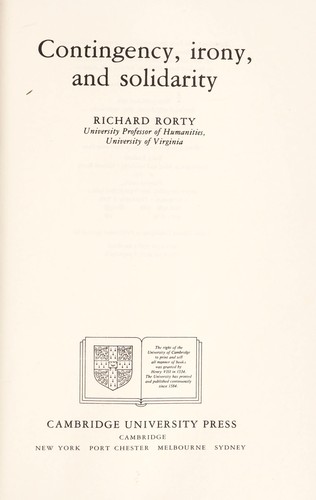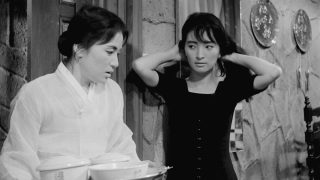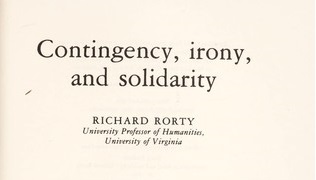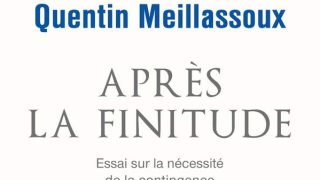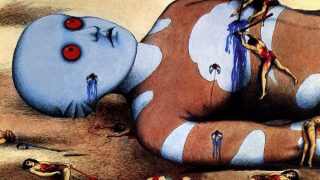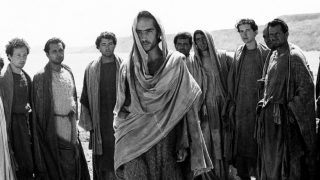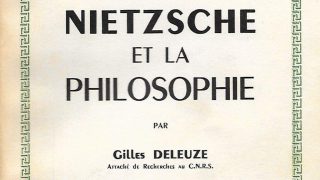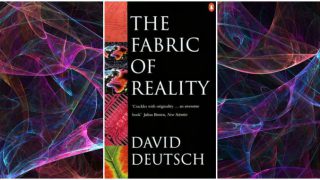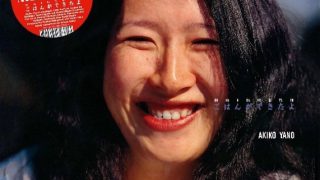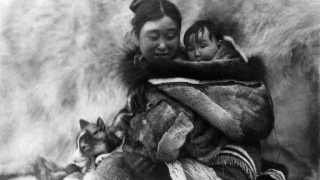Overview
“Contingency, Irony, and Solidarity“ is a book by American philosopher Richard Rorty. It was based on the two sets of lectures he gave at University College, London in 1986, and at Trinity College, Cambridge in 1987. It was published by Cambridge University Press in 1989.
Rorty is known as a figure who critically re-examined the history of modern philosophy from the standpoint of neopragmatism, which had been influenced by John Dewey’s pragmatism, analytic philosophy and postmodern philosophy, and had a wide influence on the debates over contemporary philosophy and politics.
In this book, Rorty deals with the theme of how “human solidarity“ is possible in the contemporary postmodern situation, in which it became hard for the people to share the righteousness of their beliefs with others.
According to Rorty, in the philosophies of historicism after Hegel, human languages, consciences and communities are considered as products of historical contingency, and the Platonic ideas such as objective truth and universal humanity are rejected.
As a result, intellectuals are forced to have doubts about their own righteousness at all times because they are aware that their own beliefs and desires are products of historical contingency. Rorty calls it “ironism.“
Rorty borrows the definition of the word “liberal“ from Judith N. Shklar, a political theorist born in Riga, Latvia. According to Shklar, liberal people are those who consider cruelty as the worst thing we do.
According to Rorty, to ironists, there is no theory to unite the private and the public, and demands of self-creation and of human solidarity are incommensurable. Therefore, ironists who want to be politically liberal are faced with the problem of how to balance private autonomy and avoidance of cruelty to others. It is the question of how liberal ironism is possible.
From the perspective described above, Rorty explores “the possibility of a liberal utopia“ for liberal ironists.
Rorty argues that human solidarity is a goal to be achieved by increasing our sensitivity to cruelty to others, i.e., the pain and humiliation of others.
“In my utopia, human solidarity would be seen not as a fact to be recognised by clearing away “prejudice” or burrowing down to previously hidden depths but, rather, as a goal to be achieved. It is to be achieved not by inquiry but by imagination, the imaginative ability to see strange people as fellow sufferers. Solidarity is not discovered by reflection but created. It is created by increasing our sensitivity to the particular details of the pain and humiliation of other, unfamiliar sorts of people.“ (“Introduction“)
Summary
The book consists of “Introduction“ and three parts: “Part I – Contingency“, “Part II – Ironism and Theory“, and “Part III – Cruelty and Solidarity“.
Part I – Contingency
In the first three chapters, Rorty argues that human languages, conscience and communities are nothing more than products of historical contingency.
1) The contingency of language
Here Rorty argues that language is not a medium that represents reality but a tool to deal with the world, referring to analytic philosophy such as Ludwig Wittgenstein and Donald Davidson.
Rorty distinguishes the literal use of words from the use of words as metaphors, and he states that “scientific revolutions“ (Thomas Kuhn) are re-descriptions of nature by use of metaphors (Mary Hesse).
2) The contingency of selfhood
This chapter discusses the contingency of conscience or moral consciousness, mainly referring to Sigmund Freud.
3) The contingency of a liberal community
This chapter deals with the relationship between political liberalism and enlightenment rationalism, referring to “Two Concepts of Liberty“ (1958) by Isaiah Berlin, “Dialectic of Enlightenment“ (1947) by Max Horkheimer and Theodor W. Adorno, Michael Oakeshott, Michel Foucault, and Jürgen Habermas.
Rorty argues that the vocabulary centered on the ideas such as metaphors and self-creation is more useful for liberal society than the vocabulary of enlightenment rationalism, such as truth, rationality, and moral duty.
Part II – Ironism and Theory
4) Private irony and liberal hope
Here Rorty explains his concept of an ironist, who is a nominalist and a historicist, and contrasts ironist culture with metaphysical one.
According to Rorty, Hegel broke off from the Plato-Kant tradition and founded the tradition of ironist philosophy which is continued by Nietzsche, Heidegger, and Derrida. As a result, Hegel’s “The Phenomenology of Spirit“ (1807) became a paradigm of the ironist’s abilities.
According to Rorty, in metaphysical culture, academic disciplines such as theology, philosophy and science were expected to contribute to the removal of cruelty, while in ironist culture, academic disciplines specializing in description of private realms, such as novels and ethnographies, do the work.
5) Self-creation and affiliation: Proust, Nietzsche, and Heidegger
This chapter does a comparative analysis of “In Search of Lost Time“ (1913–1927) by Marcel Proust, which is a paradigm of ironist novels, and ironist theories (Nietzsche and Heidegger).
Here Rorty also analyzes Heidegger’s dilemma (between his criticism against metaphysics and return to it) after “the turn“ (die Kehre) in the 1930s.
According to Rorty, Proust remained in his private autonomy and beauty, while Heidegger poeticized philosophy in search of publicness and sublimity, and thus he returned to metaphysics.
6) From ironist theory to private allusions: Derrida
This chapter deals with Derrida’s strategy in the 1970s and 1980s, in which he stopped talking theoretically and published esoteric texts emphasizing materiality of language, focusing on Derrida’s “The Post Card: From Socrates to Freud and Beyond“ (1980). Rorty interprets it as his abandonment of his attempt to associate the private with the public.
Part III – Cruelty and Solidarity
The 7th and 8th chapters discuss Vladimir Nabokov and George Orwell as examples of authors who warned against the potential cruelty in the quest for autonomy.
7) The barber of Kasbeam: Nabokov on cruelty
This chapter discusses Nabokov’s fear of cruelty, which is caused by a lack of curiosity about others, in his aestheticism, referring to Nabokov’s “Lolita“ (1955) and “Pale Fire“ (1962).
8) The last intellectual in Europe: Orwell on cruelty
This chapter focuses on the last 1/3 of “1984“ (1949) by Orwell, in which torture is depicted as humiliation or the destruction of personality, and reads a warning against the danger of post-totalitarianism in the future in it.
9) Solidarity
In the final chapter, Rorty argues that we have a moral duty to develop a sense of solidarity with all other human existences.
According to Rorty, our sense of solidarity is based on the idea of “one of us“. “Us” means something smaller and more local than the human race. For human solidarity, we need to keep trying to expand our sense of “us” as far as we can.
General Comment
The central theme of this book — how human solidarity is possible — is a kind of aporia (difficult problem) for us who can’t assume the ideas of enlightenment rationalism, such as human nature and the universality of reason and conscience.
If humanism is an empty concept not rooted in each group or community we actually belong to, is our pity for others just the extension of our narcissism or community egoism? What on earth should our ethics be based on?
In this book, Rorty considers this problem of ethical relativism from the standpoint of liberalism. It is a thought-provoking book that encourages readers to reflect on their own ethical values.
The book is written in plain language without jargons. It is an accessible book that is open to a wide range of readers.
“Human solidarity“ as a goal, as described by Rorty, can be understood as a “regulative idea“ (regulative Idee) or “focus imaginarius”, which Kant expounded in an appendix to “Critique of Pure Reason“. I mean, it is an unreachable goal in that we can never expand our sense of “us” to all human beings based on a single moral value, but it is a valuable and indispensable idea as an ideal in ethical practice.
One of the chief objections to this book is that it emphasizes the separation of the private and the public too much. Rorty emphasizes the incommensurability between the private and the public, but in reality a person becomes an individual through the relationship with others. This book lacks the viewpoint that considers an individual as a product of social relations.
Though I generally empathize with Rorty’s philosophical perspective and political stance in this book, what I questioned while reading it is that the expansion of “us” (said by Rorty in the final chapter) seems to be similar to expansionism of a community.
“Increasing our sensitivity to the pain and humiliation of other, unfamiliar sorts of people“ shouldn’t be the expansion of a community nor appropriation of others. It should be the reorganization of the self as “the ensemble of the social relations“ (“Theses on Feuerbach“ by Marx), which is done in the process of encountering others beyond our community interests and ethnocentrism.
